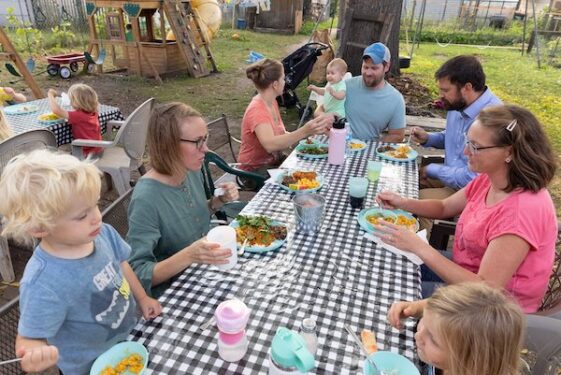
By Jonathan Liedl
ST. PAUL, Minn. (CNS) — Dinner guests at the Maurin House, a relatively new Catholic Worker community in Columbia Heights, might be tempted to describe what they see as an exceptional and lofty expression of Christian life.
Just don’t expect the two families that make up the community to necessarily agree with that.
“We really don’t think that what we’re doing is something that any ordinary Catholic couldn’t do, either,” explained Tyler Hambley, 37, who with his wife, Crystal, 38, longtime friends Colin and Leigh Miller (44 and 35), and each couple’s four children make up the Maurin House community.
The way the Hambleys and Millers live their lives, however, bucks the standard American ideal: They’ve prioritized intentional community — to the point that the Hambleys moved across the country for the sake of living next door to their close friends. They’ve converted a garage into a chapel and gather there for daily communal prayer. They open their home for an “all are welcome” style dinner two days a week. And they acquired a third house where the poor and the homeless are invited to live, joining them in community.
This might strike many Catholics as an extraordinary way of life, a response to a call to go above and beyond normal Christian practice, but that’s not how the Hambleys and the Millers see it. They say they’re just following the Gospel and the Catholic faith, plain and simple.
“It might not look exactly the same as what we’ve done, but building Catholic community, offering hospitality and being present with others, especially the poor, over a shared dish is something all Catholics can do,” he said.
In fact, the Maurin House community is guided by the conviction that these sorts of things aren’t optional aspects of following Christ — they’re integral to it.
The Maurin House is named for Peter Maurin, who co-founded the Catholic Worker movement with Servant of God Dorothy Day in 1933 in an effort to help others “live in accordance with the justice and charity of Jesus Christ” in the modern world.
“Christians are called to take personal responsibility for those who are in front of us,” Colin Miller said. “If you can take care of this homeless person who is right in front of you, don’t send them to the shelter. Don’t go up one level without having to.”
The Catholic Worker approach also emphasizes that “prayer and work are one and the same thing,” Tyler Hambley said. “Our prayers are not just words, but speech acts that can only be rendered true against the background of a form of life that makes sense of them.”
The Maurin House members’ way of life also includes voluntary poverty and a kind of mutual dependence upon each other and the generosity of others. They see this as an attempt to break free from the fragmentation of modern society and return to a more communitarian and Catholic mode of living.
“We simply must find new ways of embedding the Gospel in, or rather, of allowing the Gospel to be, the social fabric, of real local communities, or face the real possibility of not being able to practice the faith at all,” reads the Maurin House’s guiding document’s description of what Pennsylvania-based Catholic Worker and theologian Larry Chapp has described as “the Maurin Mandate.”
The Maurin House’s document makes clear that the Catholic Worker movement is not the only way of living this conviction out, but it’s also adamant that “the Gospel being what it is, and our society being what it is, intentional Catholic living will tend to take similar forms: liturgy, lay leadership, small community, local living, hospitality, simplicity, friendship with the poor, and a critical, Catholic analysis of our culture.”
The Hambleys say it was by the grace of God that they were able to purchase a home with an adjoining backyard to the Millers’ home. The two families tore down the fence between them, and set up their garage chapel, knowing that prayer together would be the basis of their communal life.
And from that common life in Christ and the conversations that surrounded it developed the various acts that define life at the Maurin House today, said Colin Miller.
“We just started inviting people to come together and join us, and then very quickly after that, we’re like, ‘Well, we’ve got to have the poor, too,’ because that authenticates, in a particular way, Christian community,” he added.
In addition to praying Evening Prayer together every day as a community, the Maurin House hosts 5:30 p.m. dinners every Monday and Friday. They’re not especially formal, but rather more “come as you are” style affairs, set in the backyard (at least when the weather permits) amid the chickens and the children.
Their dinners are open to everyone and on any given night may include a local priest, a University of St. Thomas professor and his family, a curious med school student or one of the guests staying in the hospitality house.
The hospitality house was set up in October 2021 after the Maurin House community acquired a third home across the street, allowing them to convert the house in between the other two into a place of gathering and hospitality for the poor. At any given time, three or four previously homeless men live in the house of hospitality, where they’re invited to be part of the community.
“It’s been an accidental community,” Colin Miller explained. “We didn’t set out from the beginning to say we’re going to have a hospitality house here in Minnesota. We just started living with our friends and praying together.”
The Maurin House’s members are adamant that they are not living some kind of perfect Christian life.
“We’re not really doing all that much,” Leigh Miller said.
She also acknowledged that communal life “can be really challenging, and it is really challenging. But there’s a depth to it that is really beautiful and good.”
